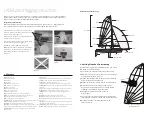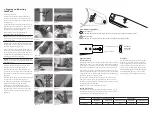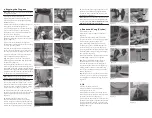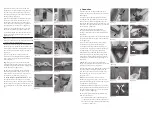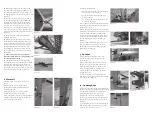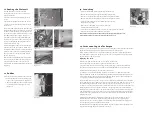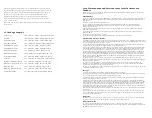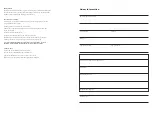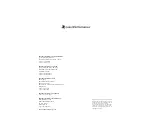
12. Rudder
1.
Attach the rudder assembly to the transom:
a. Fit the secondary rudder retaining split
ring to the top rudder pintle. (fi gure 66)
b. Ensure the primary rudder retaining clip
is adjusted and has engaged correctly.
(fi gure 66)
11. Reefi ng the Mainsail
If it is windy and you feel you will be
overpowered in the Laser 2000 it is wise to
reef the mainsail:
1.
Remove the Cunningham from the tack
eyelet.
2.
Remove the outhaul from the clew eyelet.
3. Slide the clew outhaul slug slide out of the
boom track.
4.
Uncleat the mainsail halyard and lower the
mainsail until the upper reefi ng tack eyelet is
around 100 mm above the gooseneck and the
foot of the mainsail is just beginning to touch
the thwart/sub deck as shown. (fi gure 62)
5.
Roll the sail as tight as possible from the
foot onto the port side of the sail keeping the
eyelets on the luff and the slug slides on the
leach parallel and in line.
6.
Feed the original, lower clew outhaul slug
slide in to the boom cut out fi rst, followed by
the higher reefi ng slug slide second. (fi gure 63)
7.
Reattach the outhaul control line through
the eye attached to the reefi ng slug slide as
shown. (fi gure 64)
8.
Th
read the Cunningham line through the
three eyelets in the luff of the mainsail and
refasten in the slot under the gooseneck.
9.
Retension the mainsail halyard if required.
(fi gure 65)
fi gure 63
fi gure 64
fi gure 66
fi gure 62
fi gure 65
100 mm
SLUG
13. Launching
• Raise the mainsail with the boat facing into the wind.
• Launch the boat using the appropriate launching trolley.
• Take the boat into the water with the bow facing into the wind.
• Ensure that there is enough water to fl oat the boat off the trolley.
• One person should hold the boat whilst the other gets in
and prepares to set off .
• When there is enough water below you, lower the
centerboard and rudder fully.
• Cleat the rudder downhaul in the cleat on the tiller and ensure that the
wing nut on the side of the rudderstock is tight.
Th
e rudder and centerboard should be in the fully down position at all
times when sailing an isometric boat like the Laser 2000.
fi gure 67
14. Laser 2000 Capsize Technique
Th
e use of a LaserPerformance supplied Laser 2000 mast head fl oat is highly advisable.
(Th
is device will assist in the prevention of complete inversion in the event of capsize).
When sailing your Laser 2000 in breezy or blustery conditions, it is highly probable
that from time to time you will capsize. In the event of a capsize we advise you follow
the procedure documented below:
Righting the Boat
1.
Ensure all members of the crew are accounted for and safe.
2.
If the gennaker is deployed, drop the sail back in to the sock.
3.
Release the main/jib sheets and vang (kicker) from respective cleats and ensure
the sheets are fully extended to avoid the boat sailing immediately after righting.
4.
If the boat inverts, fi rst recover the boat onto its side.
5.
In adverse conditions and with more than two crew it is recommended that the
largest crew member swim to the bow and hold the bow during righting and until all
other crew members have reboarded after righting. (Th
is ensures the boat swings in
to the safe head downwind position upon righting)
6.
It is recommended to use the “scoop” recovery system for crewmembers not involved
in the righting procedure. When the boat is on its side, the crew members to be scooped
should move to the inner lower side of the boat as close to the center of the boat as
possible. As the boat is righted, these crew members will be “scooped” onboard the boat
and will then be ready to help others reboard. “Scooping” should only be attempted
with practice and should only be commenced after the boat is stabilized on its side by a
crewmember who is securely located on the centerboard and holding the capsize right-
ing line under the gunwale. Th
is is to prevent the boat from inverting and potentially
trapping the crew.
7.
Righting is eff ected by a crewmember standing on the centerboard moving out
towards the end of the board whilst leaning out holding on to the righting line.
Th
e boat will recover to the upright position quickly. It should normally only require
one average size person to right the centerboard.
8.
Immediately after righting the tiller should be pushed fully towards the mainsail to
stop the boat sailing until all crew have reboarded.


